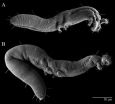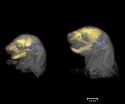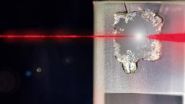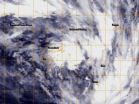(Press-News.org) COLUMBUS, Ohio – It looks like a worm and moves like a worm – sort of. But it is a previously unidentified microscopic species of mite that was discovered by a graduate student on The Ohio State University campus.
Affectionately dubbed the "Buckeye Dragon Mite" by Ohio State's Acarology Laboratory, the mite is officially named Osperalycus tenerphagus, Latin for "mouth purse" and "tender feeding," in a nod to its complex and highly unusual oral structure.
This mite doesn't resemble a mythological winged dragon, but the snake-like Chinese dancing dragons that appear in festivities celebrating each new year. What it does not resemble is a typical mite characterized by a large round body and tough external surface. And at 600 microns, or just over half a millimeter, the adult mite cannot be seen by the naked human eye.
"It is incredibly intricate despite being the same size as some single-cell organisms," said Samuel Bolton, the doctoral student in evolution, ecology and organismal biology at Ohio State who discovered this species. "That's the fascinating thing about mites and arthropods – mites have taken the same primitive and complex form and structure that they've inherited and shrunken everything down. So we're dealing with complexity at an incredibly small scale."
Bolton's description of Osperalycus tenerphagus is published online in the Journal of Natural History. It is the fifth species from this worm-like family, called Nematalycidae, to be described, and only the second from North America.
An early look at mites collected from silty clay loam soil across the street from the acarology lab suggested Bolton had found a new species. Under a compound microscope, Bolton could see that the mites he collected from a soil depth of about 20 inches had numerous straight hairs all along their bodies – technically known as setae – that didn't match the hair-like patterns on other members of this family. The hairs help these mites feel their way around.
Nematalycidae are more closely linked to sandy soils, so Bolton was surprised to find the species in a clay-like patch of earth – and he thinks digging 50 centimeters down was key to locating the mysterious creatures.
He couldn't learn all the details of his campus find until a year later, when he was able to examine the discovery in a low-temperature scanning electron microscope (LT-SEM) run by the U.S. Department of Agriculture in Maryland.
Under the LT-SEM, Bolton obtained high-resolution images of these tiny creatures and marvelled at the machinery of their mouths. Structures called rutella, which typically function in a similar way to teeth in other mites, instead support a pouch-like vessel in the front of the mouth. Bolton's theory is that the pouch acts like a nutcracker, holding microorganisms in place while internal pincers puncture the organisms and suck up their fluid contents.
Imaging mites of this size and body type require cold-temperature scanning so they aren't crushed by the intense vacuum effect of a normal electron microscope. Bolton and his co-authors froze the living mites in liquid nitrogen immediately upon collecting them, allowing for images of the mites just as they appeared in their natural habitat.
And though its movement and muscle pattern along the length of its body does resemble a worm's, the mite cannot alter its diameter in the way a worm can.
With an external surface resembling abacus beads, these mites "are like miniature accordions," Bolton said. "It's a case of convergent evolution – they have the same basic way of moving as worms, insofar as their cuticle extends and contracts, but they also have legs and, to some extent, still use them. The worm-like motion helps them move around through tight spaces."
As far as evolution goes, the Nematalycidae branch off of the tree of life from ancient groups of mites whose fossils date back 400 million years, when the environment throughout much of the world was arid.
"They're well adapted to living in extremely adverse environments – which makes them extremophiles. They're also fascinating to look at, and are interesting for addressing ecological and evolutionary questions," he said. "Because of their small size, there is very little understanding of how mites interact with their environment or other organisms."
Bolton plans to further describe this mite's complex oral structure and hopes to identify specifically what it uses for food.
INFORMATION:
This research was partly funded by a Smithsonian Institution predoctoral fellowship. Co-authors include Hans Klompen, professor of evolution, ecology and organismal biology at Ohio State, Gary Bauchan of the USDA Electron and Confocal Microscope Unit and Ronald Ochoa of the USDA Systematic Entomology Laboratory.
Contact: Samuel Bolton, (614) 292-7180; Samuel.Bolton77@googlemail.com
Written by Emily Caldwell, (614) 292-8310; Caldwell.151@osu.edu
Worm-like mite species discovered on Ohio State's campus
A species from this 'extremophile' family hasn't been described for 40 years
2014-02-28
ELSE PRESS RELEASES FROM THIS DATE:
3-D imaging sheds light on Apert syndrome development
2014-02-28
Three dimensional imaging of two different mouse models of Apert Syndrome shows that cranial deformation begins before birth and continues, worsening with time, according to a team of researchers who studied mice to better understand and treat the disorder in humans.
Apert Syndrome is caused by mutations in FGFR2 -- fibroblast growth factor receptor 2 -- a gene, which usually produces a protein that functions in cell division, regulation of cell growth and maturation, formation of blood vessels, wound healing, and embryonic development. With certain mutations, this gene ...
GOES-West satellite eyes soggy storm approaching California
2014-02-28
A swirling Eastern Pacific Ocean storm system headed for California was spotted by NOAA's GOES-West satellite on February 28. According to the National Weather Service, this storm system has the potential to bring heavy rainfall to the drought-stricken state.
The storm was captured using visible data from NOAA's GOES-West or GOES-15 satellite on Feb. 28 at 1430 UTC/6:30 a.m. PST was made into an image by NASA/NOAA's GOES Project at NASA's Goddard Space Flight Center in Greenbelt, Md. The storm's center appeared as a tight swirl, with bands of clouds and showers already ...
NASA satellite sees great freeze over Great Lakes
2014-02-28
At night, as cold settles in, lake ice creaks and groans. It's been excessively cold, and I camped exposed on the snow-swept surface. Other than the lack of vegetation and the sounds at night, you'd never know you were on a lake. It feels like an empty plain. In some places, you see pressure ridges where ice has pushed into itself, sticking up like clear blue stegosaurus plates. -- Craig Childs
Author Craig Childs is not describing an Arctic lake. He's describing the bitterly cold and frozen scene on Lake Superior, during his February 2014 trek on the ice near the coast ...
Ultra-fast laser spectroscopy lights way to understanding new materials
2014-02-28
Scientists at the U.S. Department of Energy's Ames Laboratory are revealing the mysteries of new materials using ultra-fast laser spectroscopy, similar to high-speed photography where many quick images reveal subtle movements and changes inside the materials. Seeing these dynamics is one emerging strategy to better understanding how new materials work, so that we can use them to enable new energy technologies.
Physicist Jigang Wang and his colleagues recently used ultra-fast laser spectroscopy to examine and explain the mysterious electronic properties of iron-based superconductors. ...
Detection of water vapor in the atmosphere of a hot jupiter
2014-02-28
Although liquid water covers a majority of Earth's surface, scientists are still searching for planets outside of our solar system that contain water. Researchers at Caltech and several other institutions have used a new technique to analyze the gaseous atmospheres of such extrasolar planets and have made the first detection of water in the atmosphere of the Jupiter-mass planet orbiting the nearby star tau Boötis. With further development and more sensitive instruments, this technique could help researchers learn about how many planets with water—like Earth—exist within ...
Smoke in the water: Understanding the effects of smoke compounds on seed germination
2014-02-28
Although seemingly destructive, wildfires help to maintain biodiversity and are an important element of many ecosystems throughout the world. Not only do fires discourage non-native and invasive species from becoming established, but the quick release of nutrients, heat, and compounds found in ash and smoke play an important role in the life cycle of the native flora. For plants that are adapted to ecosystems where fire is a regular occurrence—such as savannas, grasslands, and coniferous forests—exposure to fire may initiate seed germination or enhance plant growth.
Recent ...
The nature of color: New formula to calculate hue improves accuracy of color analysis
2014-02-28
A stroll through the produce aisle in your local grocery store exhibits a plethora of vivid colors. From opposing hues, like red apples next to green celery, to subtler variations, such as light to dark purple grapes, every color seems to hold its own unique attraction. Is there a way to precisely measure these hundreds of colors? This is a crucial question for scientists studying the biological importance of color in nature, but measuring color is much more challenging than measuring other characteristics, like size or weight. In recent work, University of Colorado researcher ...
Tropical Cyclone 16P forms near Fiji
2014-02-28
Tropical Cyclone 16P formed near Fiji after lingering in the region for several days as a tropical low pressure area. NOAA's GOES-West satellite captured an infrared image of the storm on February 28.
NOAA's GOES-West satellite image showed the center of Tropical Cyclone 16P to the northeast of Fiji and over Vanua Levu. Broken bands of thunderstorms wrapping from the north to the east and southeast reached Wallis and Fortuna, Samoa, Niue and Tonga.
At 0900 UTC/4 a.m. EST, Tropical Cyclone 16P was centered about 170 nautical miles/`95.6 miles/314.8 km northeast of Suva, ...
To teach scientific reproducibility, start young
2014-02-28
DURHAM, N.C. -- The ability to duplicate an experiment and its results is a central tenet of the scientific method, but recent research has shown an alarming number of peer-reviewed papers are irreproducible.
A team of math and statistics professors has proposed a way to address one root of that problem by teaching reproducibility to aspiring scientists, using software that makes the concept feel logical rather than cumbersome.
Researchers from Smith College, Duke University and Amherst College looked at how introductory statistics students responded to a curriculum ...
Asthma drug aids simultaneous desensitization to several food allergies, study finds
2014-02-28
STANFORD, Calif. — An asthma drug accelerates the process of desensitizing patients with food allergies to several foods at the same time, a new study by researchers at the Stanford University School of Medicine and Lucile Packard Children's Hospital Stanford shows.
The findings come on the heels of a recent study by the same team showing that people with multiple food allergies can be desensitized to several foods at once. The two studies, both phase-1 safety trials, provide the first scientific evidence that a promising new method for treating people for multiple food ...
LAST 30 PRESS RELEASES:
Coffee as a staining agent substitute in electron microscopy
Revealing the diversity of olfactory receptors in hagfish and its implications for early vertebrate evolution
Development of an ultrasonic sensor capable of cuffless, non-invasive blood pressure measurement
Longer treatment with medications for opioid use disorder is associated with greater probability of survival
Strategy over morality can help conservation campaigns reduce ivory demand, research shows
Rising temperatures reshape microbial carbon cycling during animal carcass decomposition in water
Achieving ultra-low-power explosive jumps via locust bio-hybrid muscle actuators
Plant-derived phenolic acids revive the power of tetracycline against drug-resistant bacteria
Cooperation: A costly affair in bacterial social behaviour?
Viruses in wastewater: Silent drivers of pollution removal and antibiotic resistance
Sub-iethal water disinfection may accelerate the spread of antibiotic resistance
Three in four new Australian moms struggle with body image
Post-stroke injection protects the brain in preclinical study
Cardiovascular risk score predicts multiple eye diseases
Health: estimated one in ten British adults used or interested in GLP-1 medications for weight loss
Exercise to treat depression yields similar results to therapy
Whooping cough vaccination for pregnant women strengthens babies’ immune system
Dramatic decline in new cases of orphanhood in Uganda driven by HIV treatment and prevention programs
Stopping weight loss drugs linked to weight regain and reversal of heart health markers
Higher intake of food preservatives linked to increased cancer risk
Mass General Brigham–developed cholera vaccine completes phase 1 trial
First experimental validation of a “150-year-old chemical common sense” direct visualization of the molecular structural changes in the ultrafast anthracene [4+4] photocycloaddition reaction
Lack of support for people on weight loss drugs leaves them vulnerable to nutritional deficiencies, say experts
Dogs’ dinners can have greater climate impact than owners’
Are you ready to swap salmon for sprats and sardines?
1.6 million UK adults used weight loss drugs in past year
American College of Cardiology comments on new dietary guidelines for Americans
American Society of Gene & Cell Therapy and Orphan Therapeutics Accelerator partner to advance and commercialize promising rare disease treatments
One in 14 patients having day case surgery have new or worse chronic pain 3 months after their operation
New study highlights link between eviction rates and gun violence
[Press-News.org] Worm-like mite species discovered on Ohio State's campusA species from this 'extremophile' family hasn't been described for 40 years





